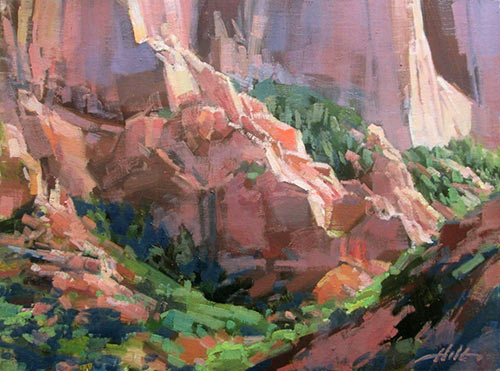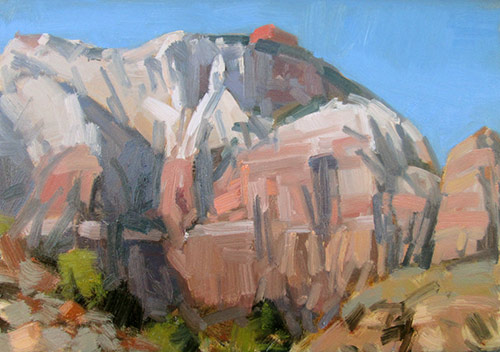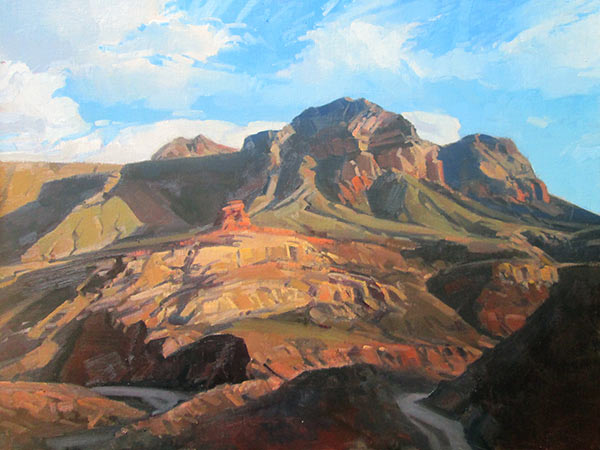In this series of articles, Utah artist J. Brad Holt talks about what artists are seeing as they look at the landscape. Holt studied geology in college and is attentive to what the rocks suggest in the scenes he paints.
Lead Image: “Virgin River Gorge Series IV,” by J. Brad Holt, 2015, oil, 18 x 24 in. Studio painting
By the end of the Paleozoic Era, all of the world’s major landmasses had come together to form the supercontinent of Pangaea. One of the consequences of this was a major change in the patterns of ocean currents. The closing of the Iapetus Ocean between Gondwanaland in the south and Laurentia to the northwest late in the Carboniferous Period resulted in the formation of the Appalachian/Caledonian mountains. At the same time, it blocked the warm equatorial current between the Tethys Sea and the Proto-Pacific. The climate changes from this were later compounded by the collision of Angaraland into the northeast flank of Laurentia, creating the Ural Mountains and completing Pangaea. This complete blockage of equatorial currents may very well have been the ultimate cause of the great Permian Extinction.
If we could have viewed it from space at the beginning of the Triassic Period, the supercontinent of Pangaea would have appeared to be a vast thick “C” shape stretching across half the world. Starting at the top of the C, in the northeast, we have Siberia/Kazakhstan occupying the polar region. Moving south and west, we pass through Europe/North America, down to the equator. Then, south and east, we move through South America, Africa, and India. The bottom of the C in the South Polar region holds Antarctica. Moving east and north, we pass through Australia.
North from this is a vast archipelago of islands and mini-continents that will eventually become China and Mongolia. Within the C shape is the Tethys Sea. Cold ocean currents along the west and southwest coasts encourage the formation of desert regions in western North America. A warm circular equatorial current in the Tethys Sea creates temperate conditions along the eastern coasts.
The Triassic Period is characterized by a lack of marine deposits worldwide, making most of these sequences land-deposited sandstones and shales. The dry conditions of western Pangaea encouraged the deposition of windblown sediment, and riverine beds. These are the Triassic red beds found in the American Southwest, and in many other regions around the world. By the end of the Jurassic Period, many thousands of feet of sand dunes had been deposited across western North America.

At this time the present-day Atlantic had begun rifting between Africa and North America, bringing more temperate conditions. This enabled both the dinosaurs and the conifers to thrive. It is thought that the drier conditions that accompanied the rise of Pangaea toward the end of the Paleozoic limited the amphibians, which needed water to reproduce. The reptiles, with their tough-shelled eggs, had an evolutionary advantage that brought about their dominance during the Mesozoic. The earliest reptiles emerged in the Carboniferous. By the Permian, they had developed into archosaurs, which would give rise to thecodonts, which would give rise to dinosaurs and birds. Parallel to the archosaurs were the pelycosaurs and the anapsids; mammals would arise out of the pelycosaurs, while lizards and snakes came from the anapsids. Modern crocodiles evolved through the thecodonts. The thecodonts during the Triassic divided into the saurischia, or lizard-hipped dinosaurs, and the ornithischia, or bird-hipped dinosaurs. Both groups became very successful through the Jurassic and Cretaceous periods.
The continents continued to break up through the Mesozoic Era. By the Cretaceous Period, Africa and North America were well separated, and South America had begun rifting away from Africa. Europe and Siberia had separated from North America. India separated from Antarctica and began its rapid journey north. The period was dominated by warm, shallow seas in the tropics. Sea levels reached their highest point as polar glaciation was almost absent. It seems as though every part of the earth spent some time underwater during the Cretaceous. The period is named for the great deposits of chalk that were laid down in the warm, shallow seas surrounding the continents at this time.
Two major events occurred at the close of the Cretaceous Period that might explain the extinction of the dinosaurs. First, it might be argued that the dinosaurs are not extinct, as they gave rise to the birds, which are still going strong. The first birds are found in the mid-Jurassic. It may be that their success, like that of the mammals, had something to do with being warm-blooded. Both the aforementioned events would have caused a rapid period of climate cooling, which may have favored the evolutionary success of this attribute.

The first event was the outpouring of vast quantities of basalt on the Indian subcontinent. These deposits are known as the Deccan Traps, and they are large enough to have caused climate fluctuations. The other event was an asteroid impact on the Yucatan Peninsula, which was large enough that a layer of rare iridium was laid down worldwide at the KT Boundary, which marks the end of the Mesozoic Era. It may be that the combined power of these events was enough to initiate the extinctions.
The Mesozoic Era is dominated by the supercontinent of Pangaea. The age of the dinosaurs coincides with the period in which the supercontinent began to break up into forms that resemble those we recognize today. On a personal level, the legacy of Pangaea is the Mesozoic strata that comprise the dramatic landscapes that I live in, and that I spend my time painting.




